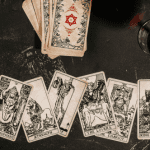 Creepy
Creepy  Creepy
Creepy  Technology
Technology 10 Scientific Breakthroughs of 2025 That’ll Change Everything
 Our World
Our World 10 Ways Icelandic Culture Makes Other Countries Look Boring
 Misconceptions
Misconceptions 10 Common Misconceptions About the Victorian Era
 Mysteries
Mysteries 10 Strange Unexplained Mysteries of 2025
 Miscellaneous
Miscellaneous 10 of History’s Most Bell-Ringing Finishing Moves
 History
History 10 Great Escapes That Ended Right Back in Captivity
 Weird Stuff
Weird Stuff 10 Fascinating Things You Might Not Know About Spiders
 Food
Food 10 Everyday Foods You Didn’t Know Were Invented by the U.S. Military
 History
History 10 Odd Things Colonial Americans Kept at Home
 Creepy
Creepy 10 More Representations of Death from Myth, Legend, and Folktale
 Technology
Technology 10 Scientific Breakthroughs of 2025 That’ll Change Everything
 Our World
Our World 10 Ways Icelandic Culture Makes Other Countries Look Boring
Who's Behind Listverse?

Jamie Frater
Head Editor
Jamie founded Listverse due to an insatiable desire to share fascinating, obscure, and bizarre facts. He has been a guest speaker on numerous national radio and television stations and is a five time published author.
More About Us Misconceptions
Misconceptions 10 Common Misconceptions About the Victorian Era
 Mysteries
Mysteries 10 Strange Unexplained Mysteries of 2025
 Miscellaneous
Miscellaneous 10 of History’s Most Bell-Ringing Finishing Moves
 History
History 10 Great Escapes That Ended Right Back in Captivity
 Weird Stuff
Weird Stuff 10 Fascinating Things You Might Not Know About Spiders
 Food
Food 10 Everyday Foods You Didn’t Know Were Invented by the U.S. Military
 History
History 10 Odd Things Colonial Americans Kept at Home
10 Disturbing Superstitions That Killed
Humanity has always had a thing for superstitions—those quirky, often nonsensical beliefs that spice up our lives with a touch of paranoia. They have us knocking on wood when we tempt fate, giving black cats the side-eye, and detouring around ladders like they’re crime scenes. Harmless, right? Not always. While most superstitions are charming little rituals passed down from generation to generation, others have taken truly dark turns.
History is brimming with tales of people taking these blind beliefs to absurd and deadly extremes. These aren’t your run-of-the-mill, laugh-it-off superstitions—they’re high-stakes tragedies fueled by fear, folklore, and a shocking lack of critical thinking. They’re the stories that make you cringe and mutter, “Who thought that was a good idea?”
We’re talking gruesome executions, mass panics, and mind-boggling acts of misplaced faith—all with a heavy dose of irony. After all, what’s more tragic (and a little darkly funny) than trying to ward off bad luck only to end up as a cautionary tale in someone else’s history book? So here are 10 superstitions that didn’t just scare people—they literally killed.
Related: Top 10 Most Popular & Universal Superstitions around the World
10 Killing Left-Handed People
If you’re a lefty who’s ever wrestled with scissors designed for right-handed people or smeared ink all over your paper while writing, you’ve probably felt like the world wasn’t built with you in mind. But if you think that’s frustrating, try being a left-handed person in the past when fitting into society wasn’t just inconvenient but downright lethal. In many societies, being a lefty wasn’t simply a quirky trait—it was practically a definitive RSVP to the devil’s dinner party.
The word “sinister” literally comes from the Latin for “left,” and oh boy, did people take that etymology and run with it—straight to the nearest witch trial. Teachers, ever the champions of compassion, used to tie children’s left hands behind their backs, forcing them to write with their right hands in a misguided attempt to “fix” them. Instead of getting an A for effort, these kids ended up with trauma and an uncanny ability to loathe calligraphy forever.
Here’s where it got deadly. Then came the witch-hunting frenzy in Europe, where being left-handed wasn’t just frowned upon—it was evidence you had a direct line to Lucifer. Some unlucky lefties were accused of sorcery or witchcraft and executed. Imagine being burned at the stake, not for evil deeds but because you opened a jar counterclockwise.[1]
9 Redheads in the Middle Ages
In the Middle Ages, redheads were viewed with a mixture of fascination and fear. Their bright, striking hair wasn’t just a rarity—it was believed to be a sign of something sinister. For centuries, people believed that red-haired individuals were cursed by the devil himself. Are we already seeing a pattern? Whether it was due to their fiery locks or a supposed otherworldly connection, redheads were often associated with witches, demons, and dark magic.
This superstition wasn’t just idle gossip; it had real, deadly consequences. In some regions, red-haired people were accused of witchcraft and subjected to horrific trials. During the witch hysteria of the 15th and 16th centuries, redheads were disproportionately targeted and executed. It was believed that their fiery appearance made them more prone to evil deeds—perhaps because they burned hotter or maybe because the devil just had a thing for auburn hues.
Being judged solely on hair color left no room for those with the ginger gene to defend themselves as human individuals rather than harbingers of doom.[2]
8 Sati
Who needs a maid when you’ve got a widow? In the superstition-fueled practice of sati, it wasn’t just about eternal devotion—it was also a DIY spiritual power wash. Women in India were expected to join their husbands on the funeral pyre, a fiery exit that supposedly scrubbed away all the sins of both spouses and their family. Yes, you read that right: Your in-laws’ bad karma was erased, courtesy of one flesh-flaming sacrifice.
But hold tight—there’s more! Sati wasn’t just a karmic cleansing; it was also seen as a way to prevent “disgrace.” The supposed logic was that if a widow was alive, she might dishonor the family by, you know, existing. So naturally, the only solution was a full-body roast. Talk about pressure—not only do you lose your husband, but suddenly, you’re the moral linchpin for generations of relatives who couldn’t stop sinning.
It’s the kind of superstition that would make even the most overachieving spouses say, “I think I’ll sit this one out.” Thankfully, the practice was outlawed, though not before countless women were forced into a role no one signed up for: the family’s last line of karmic defense.[3]
7 Human Sacrifices to Stop Volcanoes
When a volcano erupts, most people think of evacuations, scientific monitoring, or maybe calling the local news to dramatically announce the end is nigh. But in ancient civilizations, not so much. Their strategy was more… primal. Human sacrifice was the go-to solution because clearly, nothing says, “Let’s cool this molten hellfire,” like offering up a blood tribute.
In Hawaii, legends tell of sacred offerings made to Pele, the fiery and tempestuous volcano goddess, to appease her volcanic wrath. There’s a lot of speculation about various cultures chucking humans into volcanoes to halt eruption, but one of the more concrete accounts was not recorded until recent times in Indonesia, when human sacrifice was practiced to appease the Broma volcano.
While modern geology confirms this didn’t actually reduce lava flow (shocking, right?), it did cement a grim legacy: tackling natural disasters with what could only be described as the world’s worst insurance policy—sacrificial insurance. The volcano didn’t chill out, but the community could at least sleep soundly, knowing they’d tried their best… with someone else’s life.[4]
6 The Werewolf Trials of France
Werewolves weren’t always the makings of romantic young adult novels or Halloween costumes. In the 16th and 17th centuries, they were a terrifying superstition that led to real-life hunts—seriously. In rural France, werewolf hysteria gripped communities, and the solution wasn’t a trip to the vet or therapy—it was putting people on trial for lycanthropy.
Accusations of being a werewolf often started with something as simple as being a little too hairy or spending too much time outside at night. Villagers, fearing livestock killings or strange disappearances, would quickly point the finger at the nearest socially awkward neighbor with thick sideburns. Those accused were put through gruesome trials, often involving torture, where confessions were extracted under pressure—because what screams guilty more than being forced to admit you’re a wolf?
One of the most infamous cases was that of Gilles Garnier, a French recluse accused of werewolfism in the 1570s. After some, of course, intense interrogation, Garnier confessed—probably because he had no other choice—that he had been stalking children in the forest in his wolf form. He was found guilty and, unsurprisingly, burned at the stake.
The werewolf trials were a strange concoction of superstition, mass hysteria, and an easy way to eliminate those who didn’t quite fit in. Today, they stand as a testament to the dangers of fear—and a reminder to appreciate your hairy and socially awkward neighbors just the way they are.[5]
5 Dancing Plague of 1518
Picture a dance party so wild it turns deadly—like the worst (and longest) Zumba class imaginable. That’s quite like what went down in Strasbourg in 1518 when dozens of people began dancing uncontrollably in the streets. At first, it seemed like harmless fun, just a bit of spontaneous medieval groove. But as the days went on, this impromptu rave spiraled into a marathon of misery. Participants couldn’t stop moving, eventually collapsing from overexertion.
Local authorities, in their ever-infinite wisdom, decided the solution was… more dancing. They hired musicians, hoping the dancers could boogie the curse out. As one might assume, this backfired spectacularly. It was like curing hypothermia by building an ice rink. To this day, no one knows the cause of the plague, but it’s proof that even in medieval times, people just couldn’t stop the beat.
To this day, the cause of the plague remains a mystery. Was it mass hysteria? Ergot poisoning from moldy bread? A town-wide cardio challenge gone horribly wrong? No one knows. But one thing is certain: even in medieval times, people just couldn’t stop the beat.[6]
4 The Superstition of Blood Libel
The Middle Ages: a time when bathing was optional, but accusing entire communities of child murder was totally on-trend. Behold blood libel, the deadly superstition that claimed Jewish people kidnapped Christian children to use their blood in rituals despite Judaism forbidding the consumption of blood (nice try, medieval rumor mill).
This gem of collective paranoia started in 12th-century England and spread across Europe faster than an alarming TikTok trend. Accusations required zero evidence (because apparently hysteria trumped facts), and the results were catastrophic: wrongful executions, mass expulsions, and mob violence. All because someone decided their wild imagination was courtroom-worthy.
Shockingly (or not), this superstition refused to die, popping up even in the 20th century. Because if history has taught us anything, it’s that humanity sometimes loves recycling its worst ideas.[7]
3 Cursed Twins
To most of us, twins are just two identical human beings, making us ask, “Wait, which one are you again?” But in parts of Nigeria, despite twins being praised in neighboring parts, twins brought less “awws” and more “oh nos.” People believed twins were bad omens or even evil supernatural beings. Twins were often abandoned, killed, or otherwise “dealt with” to save everyone from cosmic disaster. Geez, and here I am complaining of being an unheard middle child.
But, hey, three cheers to the next time we mix up twins’ names in gratitude that we’ve traded life-or-death superstition for mild social awkwardness. Progress is a beautiful thing![8]
2 Foot Binding
If you’ve ever looked at a pair of tiny shoes and thought, “Wow, how do I get my feet to look like that?” Well, in ancient China, you were in luck—if you didn’t mind intense pain, lifelong disability, and the possibility of death.
Footbinding, which became widespread during the Tang Dynasty (roughly the 10th century), was seen as the ultimate mark of beauty and femininity. The idea was simple—start binding a young girl’s feet when she was between four and eight years old and gradually compress her toes into an excruciatingly small space. This resulted in “lotus feet,” which, despite sounding like an exotic flower, were actually a mangled mess of bone, flesh, and broken dreams.
It gets better. The process was eventually done to make women more marriageable and symbolize social status. And it didn’t stop there, oh no. Infections, gangrene, and sometimes death were outcomes for those who had to live with their newly “perfect” feet. All for the sake of a beauty ideal that no one dared question because, well, tradition.[9]
1 Killing Albinos in Africa
In some parts of Africa, people with albinism have the unfortunate honor of being treated like lottery tickets—scratch off a body part, and apparently, riches or luck might follow. No, really. There’s a belief that albino body parts hold magical powers, which has led to gullible and greedy hunters of human beings.
Organizations in countries like Tanzania and Malawi are pushing back hard, fighting these beliefs with education, advocacy, and sheer determination. It’s not easy undoing centuries of superstition, but they’re making strides. As for the superstitious crowd? Maybe it’s time to pivot from “albino parts for prosperity” to, I don’t know, buying a lotto ticket like the rest of us.[10]








